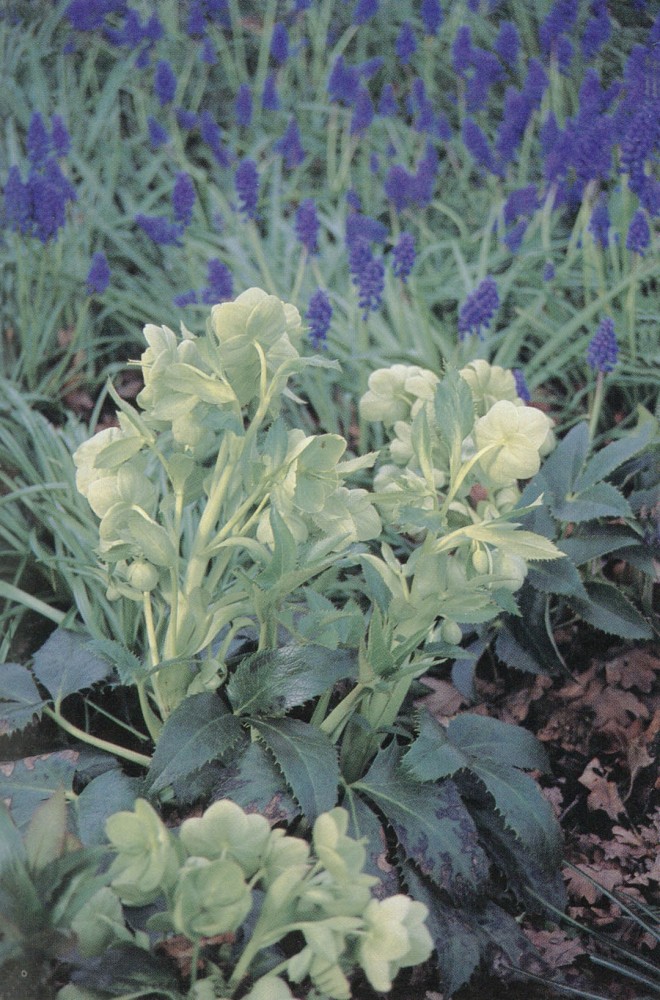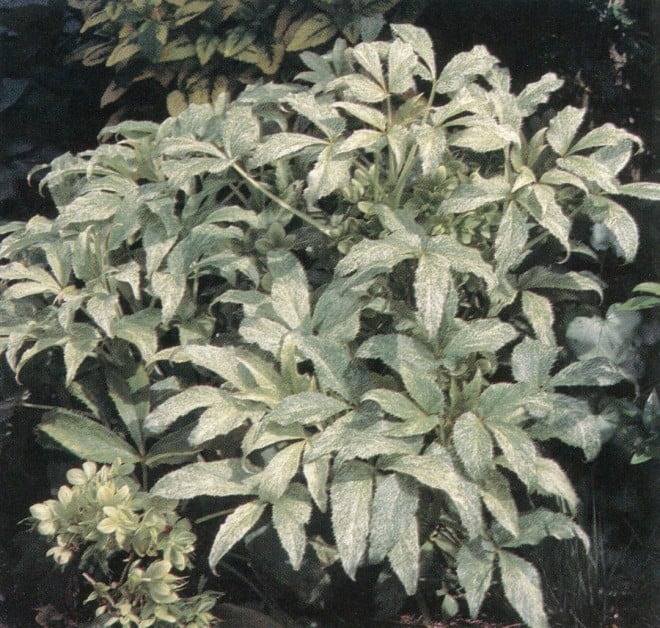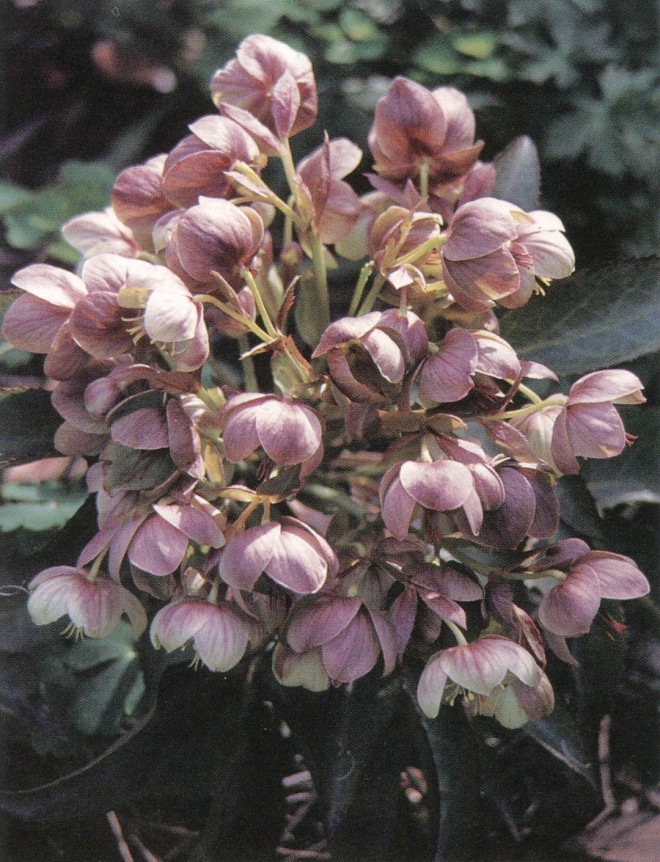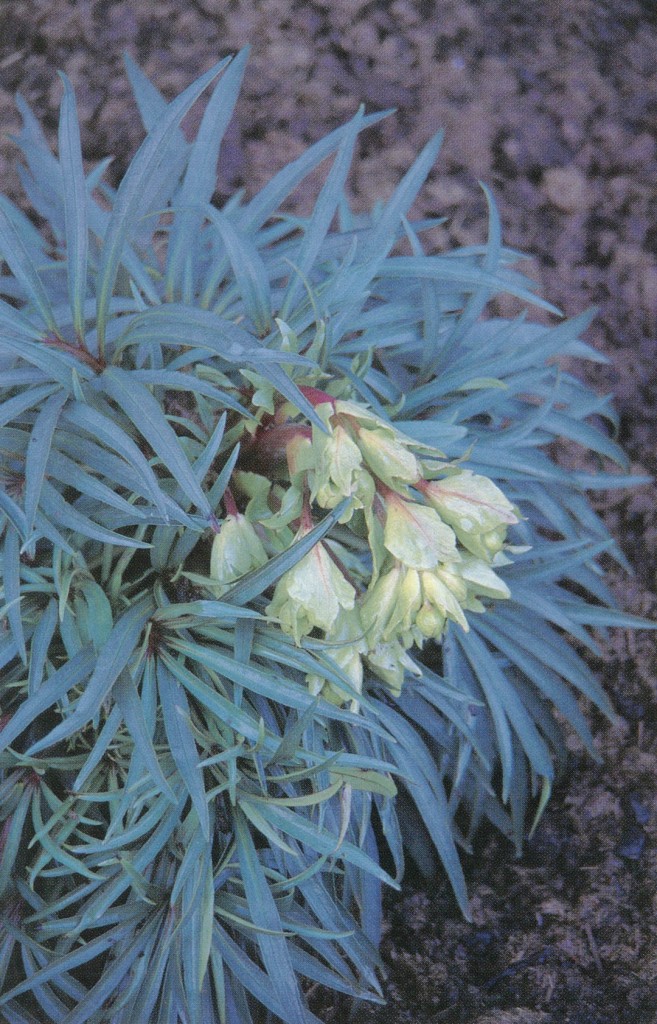
Caulescent Hellebores… A Hint of Silver, a Touch of Platinum

Contributor
- Topics: Plants You Need
Hellebores are an addiction.
Christopher Lloyd, Christopher Lloyd’s Garden Flowers
Gardening and gossip seem to be of the same genre, which is perhaps why so many who engage in the former are so adept in the craft of the latter. It is not so much the triumphs along the way but rather the accompanying myths and broils that pique our interests. So, as it were, my experience with the caulescent hellebores possesses both the conquests and conflicts we have come to associate with our gardens, and I welcome the tête-a-tête regarding my relationship with them.
The genus Helleborus is relatively small (about fifteen species), and the caulescent, or stemmed, hellebores comprise only a quarter, represented by H. argutifolius, H. lividus, H. foetidus, and H. vesicarius along with assorted hybrids between them. Their growth habit differs from the stemless species by the having flowers in terminal heads atop monocarpic stems that appear annually from the roots. This trait becomes both a perk and curse for the gardener. While the plants generally possess more year-round presence, as well as an enhanced floral carriage, the foliage is subjected to the ravages of normal wear and tear for nearly an entire year before flowering commences. The effect might be compared to that of a bejeweled broach worn upon a soiled gown—hardly a civil way to introduce a quartet of my favorite plants, but an honest assessment none-the-less. No gossip here.

Helleborus argutifolius
Helleborus argutifolius (once known as H. corsicus and as H. lividus ssp. corsicus) is a variable species in cultivation but generally recognizable. Found naturally on the islands of Corsica and Sardinia, the leathery, jagged-edged, trifoliate leaves, carried on stems from one to three feet tall, possess an impressive platinum cast on an otherwise light green base. Topping each foliage mound is a conical, terminal inflorescence comprised of up to thirty, large, frosty green flowers with a central boss of equally green stamens. An unblemished garden specimen of H. argutifolius in full flower in early February, for instance in concert with the throaty indigo of a grape hyacinth like Muscari latifolius, creates a stunning effect in the winter garden. The sad truth is that, in our garden on the Puget Sound’s Kitsap Peninsula (Sunset zone 5), the scourge of botrytis usually hits the leaves by flowering time. After disfiguring the foliage with an embarrassment of open sores, the fungus moves on to the flowers, which are soon clogged with an ooze of gray mycelium. I like it nonetheless. However, it is better suited to the decidedly more mediterranean climate of southern Oregon and California.

For good reason, there are few named clones of the caulescent species or hybrids. Though the acaulescent hellebores are stingy in offering up divisions, the caulescent species, with their woody rootstocks, are downright belligerent. In addition, though some have been successful in getting hellebores into the test tube for tissue culture, getting them back out alive has been problematic. Yet, from Helleborus argutifolius, several dependable seed lines have been established in cultivation. Among these are two notable variegated forms introduced in recent years. Helleborus argutifolius ‘Janet Starnes’ was selected in Oregon by a nurserywoman of the same name; ‘Pacific Frost’ appeared in the garden of Pamela Frost of Vancouver, BC. When well grown, both are quite garden worthy. In my own experience, the latter has proven to be a more vigorous and long-lived plant. To the best of my knowledge, however, this observation is not universally supported.
Helleborus lividus
Though my experience in growing this first species is the most extensive of the four, I suspect that, in truth, I have never actually grown or seen true Helleborus argutifolius. Regularly posing as an imposter is H. x sternii, a common but variable hybrid with H. lividus. Helleborus lividus, from the western Mediterranean islands of Majorca and Carera, is a striking beauty, with intense, steely blue leaves veined in ghostly gray. This effect is apparent even in the cotyledon stage, making it simple to identify trays of germinated seeds. Add to this flowers in varying degrees of dusky rose on darker-stained stems and you can imagine how extraordinary a well-grown plant would be. Actually, I can only imagine how one might look, as it has proven to be an unreliable garden plant here in the Pacific Northwest. As I have so often observed of plants not meant for our damp climate, at first it’s ugly, and then it dies. What portions of the plant are left after various fungal diseases have had a go are finished off by our winter temperatures, even in a normal year.

The hybrid between Helleborus argutifolius and H. lividus, Helleborus x sternii, is named after Sir Frederick Stern, one of the first to exhibit such hybrids in the late 1940s. This hybrid salvages the situation somewhat by offering a broad spectrum of variation within its ranks. Unfortunately, seedlings at the extremes of this spectrum have often slipped through commerce as one of its parents, thoroughly muddling the horticultural taxonomy of the two species. Many seedling strains, such as ‘Boughton Beauty’, ‘Blackthorn Strain’, and, more recently, ‘Bulmer’s Blush’, lean heavily towards the more seductive yet fragile character of H. lividus, their teal-leafed, pink-suffused parent. There is much work to be done in developing a hybrid between these two species that will offer durability and disease resistance as well as vivid tones in foliage and flower.

These three taxa are the only ones that have been successfully hybridized with Christmas rose (Helleborus niger), known for its dreamily large, early winter, white flowers but falling within another distinct subgroup of hellebores. The result is an assemblage of sensational, mostly sterile hybrids: Helleborus x nigercors (H. niger x H. argutifolius), H. x ericsmithii (H. niger x H. x sternii), and H. x ballardiae (H. niger x H. lividus). Each combines the hardiness of Christmas rose with the presence and color of its stemmed parent, along with an added dose of hybrid vigor, resulting in stemless progeny sporting wonderfully silvered foliage and large, nodding, satiny cups of raspberry-cream—more aptly worshipped than grown. As tissue culture propagation for hellebores is perfected, there will certainly be named selections of these hybrids made commercially available; for now, it’s simply a matter of “get what you can” or make your own at home.

Helleborus foetidus
Among the stemmed species, my favorite tot of the lot is stinking hellebore (Helleborus foetidus); I find the common name unfortunate, as I have never associated any unpleasant scent with this species. As I finish this article in late October, flower buds have already begun to unfurl on the plants in my garden. By Christmas, the many-flowered panicles will be held high above fifteen-inch stems clothed with highly textured, spidery-cleft leaves. The individual flowers—nodding, rosy-rimmed cups of green—are not particularly showy, but the collective display produces a worthy pageant of winter color, less ephemeral than most. I will be as impressed with the flowers on my colonies of stinking hellebore in early April as I am now in the eroding days of late autumn. In the wettest years, my plants will suffer from botrytis, though it seldom becomes a significant concern.
The cultivars of Helleborus foetidus are as problematic in their muddled taxonomy as are the other hellebores, though the strains have been segregated for a long enough time for us to begin to define what characteristics each should possess. There are numerous cultivar names in commerce today, but I believe that most represent nothing more than open-pollinated, unblossomed seedlings. In any event, the cultivar descriptions are so vague (“a tall variety with pale green leaves and green bracts that are brighter than most…”) that the buyer could never be totally certain of what was being offered.

An exception may be the variable but beautiful ‘Wester Flisk’: it offers metallic, teal blue fingerlings of foliage held on claret-suffused stems, with rose colored bracts amidst masses of chartreuse flowers. These traits come fairly true from seed if the parent plants have been isolated from green-leafed selections. Currently on trial in our garden are two additional strains that have, thus far, met with general approval. Helleborus foetidus ‘Variegata’ mimics the speckled leaves of H. argutifolius ‘Pacific Frost’ but with more finely textured foliage. The cunning leaves of ‘Chedglow’ approach the color of an overripe lemon, an effect echoed by the soft yellow flowers. Helleborus foetidus is reticent to hybridize with other species.
Helleborus vesicarius
The last in this quadrant of species, Helleborus vesicarius, has perhaps limited horticultural application in the Northwest due to its exacting climatic requirements. Found naturally on the border of southeastern Turkey and Syria, this arid-loving hellebore makes the most of early winter rains, producing clumps of somewhat fleshy leaves and flowers that are similar to those of H. foetidus. The plant slips into dormancy in early summer but not before offering a unique display of large, inflated, bladderlike fruits. These ripen to a tawny brown before the pods break free, dispersing their seeds as they tumble across the Syrian plains. We cultivate this species in gritty compost in containers and offer protection from our soggy winter weather.
This exceptional subset of hellebores certainly presents the gardener with challenges in their selection, siting, and successful cultivation. Most of those noted here will perform better in the warmer, drier parts of the West Coast, from Oregon to Southern California. I defame the reputation of these plants as a parent might a rowdy child. Noting their pitfalls is simply an integral step in developing an appreciation for all plants, while reveling richly in their shining moments.
Share:
Social Media
Garden Futurist Podcast
Most Popular
Videos
Topics
Related Posts

Low Maintenance Gardens – Better for Pollinators and People
Autumn 2022 “I come out every day. It’s therapy, my meditation.” Janet’s young garden transformed from overgrown, invasive plants to mostly natives. The dailiness of

Calochortophilia: A Californian’s Love Affair with a Genus
Summer 2022 I can chart the progression of my life by Calochortus. For the last two decades, at least. As a teenage girl growing up

Pacific Plant People: Carol Bornstein
Spring 2022 Public gardens play a key role in demonstrating naturalistic planting design, selecting native and adapted plants for habitat, and testing techniques for reducing

Add Year-Round Interest and Winter Blooms for Pollinators
Spring 2022 This article was created from an Interview by Merrill Jensen with Neil Bell in the Summer of 2021 for our Pacific Plant People











Responses